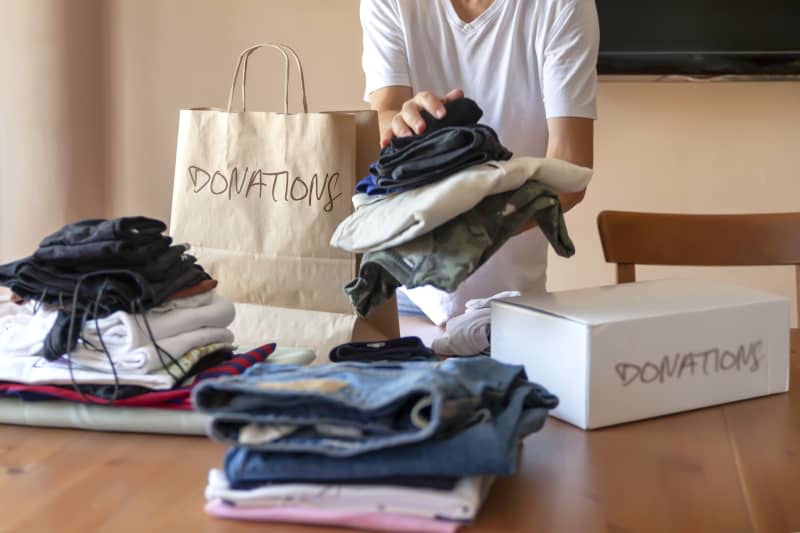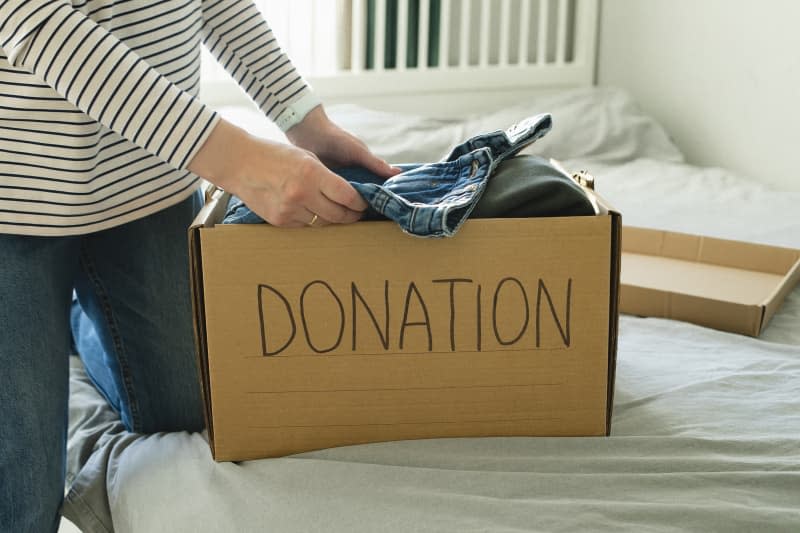6 Things You Should Never Do When Donating Your Stuff

Every season motivates me to pare down my belongings in its own way. First, there’s the start of a new year, where I feel invigorated to make positive changes, followed by the jump start of spring, and then the final cleanout when chilly fall weather hits. And no matter the time of year, when I’m in a purging mood I often donate my castoffs to a local charity shop.
If you, like me, find yourself in declutter mode, you may be tempted to box everything up, toss it in the car, and head to your local thrift shop. And while you have good intentions, your unwanted goods can sometimes create more work for employees, which begs the question: What shouldn’t you donate? I asked employees at two of my favorite thrift stores their thoughts, and here are six mistakes they say to please avoid when making your next donation.
You’re donating unsanitary items.
Throwing goods into the trash may go against every fiber of your being, but even if it’s difficult, secondhand underwear — meaning panties and briefs that cover private areas — should simply be tossed. “We get donations of silly things like used underwear that I would not like to have to touch,” says Kloie Rogers, the store lead at Mission Thrift in Lynchburg, Virginia, where profits go to support local vulnerable communities. Acceptable undergarments include things worn on top, such as T-shirts and sports bras, but clean these thoroughly before putting them into your donation pile.
However, germy items don’t stop at undergarments. Other pathogen-laden things to avoid donating are mattresses (most charity shops won’t take these as donations anyway) and wet or stained clothes. Many plush toys also fall into this category unless they’re valuable, new, or vintage, but Rogers has another solution for these soft items. She adds, “We also get a lot of stuffed animals, and while we do sell these, we get an overload amount, so I always recommend these being donated to a Humane Society for pets.”
You’re giving electronics that customers can’t test.
If you have a lamp, drier, or chandelier you’d like to donate, test it and ensure it has all its pieces first. “Some of our pet peeves are donated items that are filthy, broken, or have missing parts,” says Cheryl Jordan, the resale manager and volunteer coordinator at TEAM in Tomball, Texas. The shop relies on donations of new or gently used goods to fund its locally focused programs and the organization’s operating cost, so having quality items to resell is critical.
Jordan also cites that they can’t sell used ceiling fans or light fixtures that must be hard-wired into electricity. While you can easily test a curling iron or toaster in-store, other appliances can become a burden if they’re not functioning properly. However, Mission Thrift sells large appliances, such as refrigerators, washers, and dryers, so check with your local charity shop to see what they take. And don’t ever donate something that’s not in working order.

You’re bringing wrinkly clothes.
Have a load of clothes to donate? Help set the thrift store’s sales up for success by ensuring they’re wrinkle-free so employees can easily hang the clothes and put them on the sales floor. “It is always best to make sure your items aren’t wrinkly so that you can ensure they will be able to be used in our store,” says Rogers. Instead of tossing everything into a bag where they’ll ball up, Rogers suggests folding clothing and placing it neatly into a box.
You aren’t scanning for damage.
Again, having items in tip-top shape is essential for the shop to resell your donations. So, give your stuff a once-over before plopping it into the dropoff bin. According to both of Rogers and Jordan, things to check for include the following: chips in glass items, books with pages ripped out, cracked or scratched DVDs, and fabrics (think: clothing and upholstery) with unintentional rips or stains. As you place items into your box, examine each piece for damage before sending it off.

You’re dropping things off after hours.
If one thing takes the cake for Jordan, it’s when folks don’t respect the dropoff parameters. “Donations left outside of donation hours tops the list,” she reveals. Although charity shops appreciate your excitement about giving to their organization, leaving items unattended means they can get stolen or ruined by the weather. While it can be tempting to finally drop off the bag you’ve had in your trunk for the past three months, hold off until the store is receiving donations.
You may be leaving something behind unintentionally.
One of the most interesting mistakes Jordan has experienced is seeing things that the donor didn’t necessarily mean to leave behind. “Some donations that gave us a shock or a second look were dead mice and large spiders,” she says. She’s also found sentimental belongings where the owner was tracked down and grateful to have the items back. Whether it’s an unexpected critter or a priceless heirloom, check drawers and pockets before heading off to the thrift to say a final goodbye to your goods.

